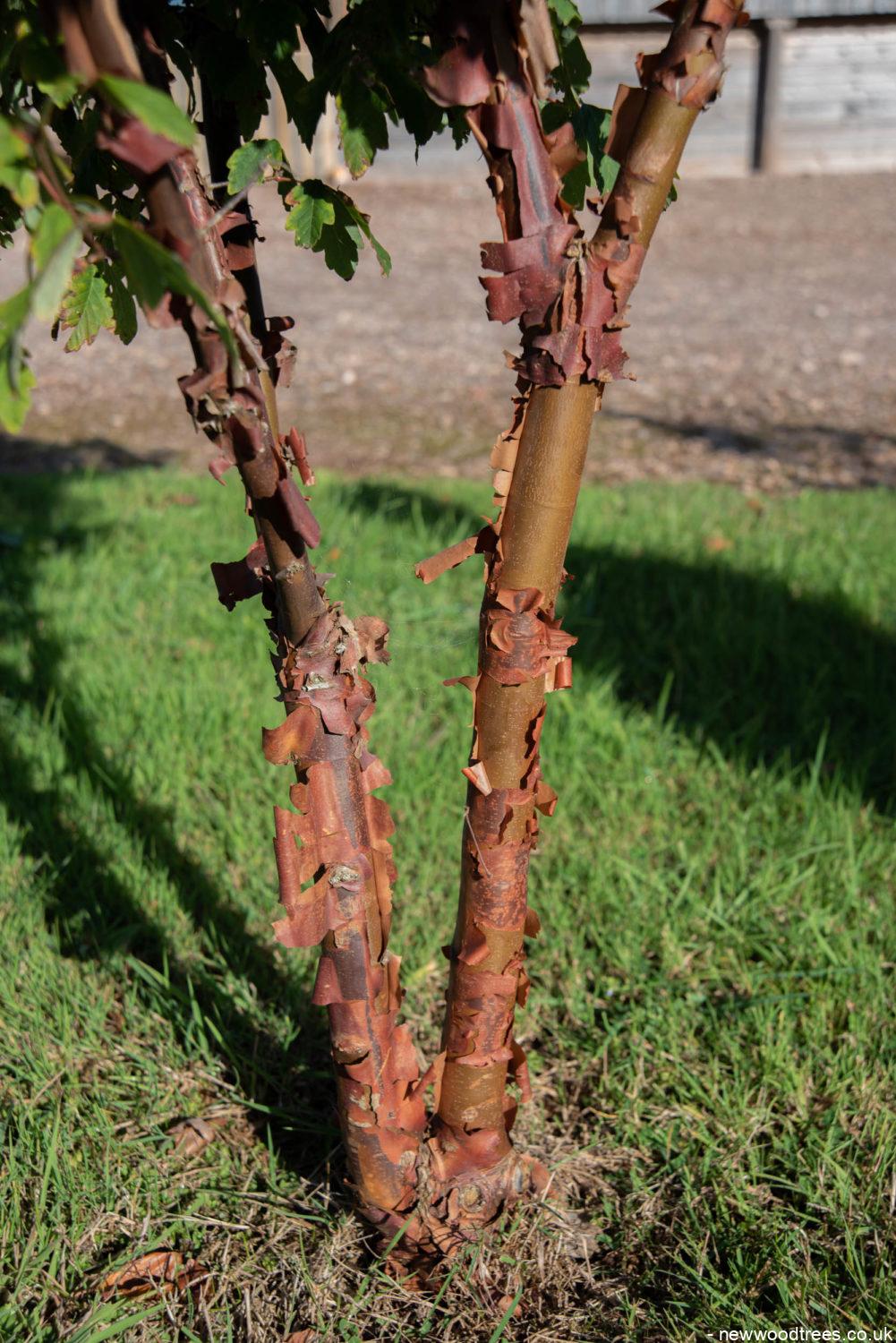Tree bark may seem like an afterthought, but it can be fascinating upon closer inspection. Many tree species, significantly smaller ornamental varieties, have uniquely textured and coloured bark that provides aesthetic interest throughout the year. When selected carefully, small trees with distinctive bark can add visual flair and become a central focal point in landscapes or gardens.
This blog tends to highlight six compact trees celebrated for their remarkable bark qualities. From rainbow trunks to camouflage patterns, exploring the diversity of tree bark gives a new appreciation for the ornate beauty of nature.
1. Paperbark Maple
Hailing from Japan, the paperbark maple (Acer griseum) is foremost among small trees celebrated for its superb bark. Newer bark on the paperbark maple emerges a rich cinnamon red, providing a season-long warm colour. However, it’s the older bark that forms the paperbark maple’s most striking feature.
As the bark ages, the outer layers slowly peel away into curly, chestnut-brown sheets resembling paper scrolls. This exfoliating bark gradually reveals the orange-red underbark beneath for an eye-catching colour combination.
The peeling bark of the paperbark maple occurs incrementally over time, lending great textural interest. As some sections exfoliate while others remain intact, the mosaic effect reminds some of a jigsaw puzzle. No two paperbark maples are precisely alike in their patterns. Combined with the tree’s naturally upright oval shape, the paperbark maple’s unrivalled exfoliating bark makes it exceptionally ornamental. It thrives as an understory tree in partial sun, growing 20 to 30 feet high and wide. For small residential landscape spots, it packs outstanding four-season appeal.
2. Prunus serrula
The prunus family harbours many compact ornamental trees with polished bark, but few equal the birch bark cherry (Prunus serrula) for year-round elegance. Native to China and Tibet, this graceful Tibetan cherry tree has bark that peels into curling vertical strips resembling shiny copper-brown birch.
Against this richly coloured background, the black cherries and crimson autumn foliage finely contrast for added seasonal interest. Gracefully vase-shaped, it grows slowly up to 20 feet high and 15 feet wide.
The exfoliating bark of the Prunus tree provides winter texture and beauty, especially when backlit by morning or evening sun—some varieties like ‘Golden Cloak’ showcase sunny green-yellow bark for even more pop. Tolerant of pollution and urban conditions, the birch bark cherry makes a stunning specimen tree for Asian-style gardens or contemporary landscapes. Plant it where the bark can be admired up close, and you’ll be drawn to touch the curled strips coiling along its trunk and branches. For refined four-season beauty in a petite package, a few small trees match its splendour.
3. Cornus mas
The cornelian cherry dogwood (Cornus mas) is a deciduous flowering dogwood native to Europe that brings multi-season pleasure to gardens. In spring, it blooms with clusters of petite yellow flowers, followed by Scarlett cherry-like fruit in summer and rich red-purple leaf colour in fall. But its standout feature is the eye-catching bark that develops as the tree matures. On older specimens, the bark flakes and exfoliates in small rectangles to reveal striking grey, brown, and orange-red undertones. When backlit by the sun, these colours glow beautifully.
Slowly growing to around 20 feet high and wide, the cornelian cherry dogwood works well in borders and foundation plantings where its patchwork bark can be admired up close. The small tree flowers at a young age and has more excellent pest resistance than other dogwood species. Choose famous cultivars like ‘Variegata’ for variegated leaf margins or ‘Golden Glory’ for intense coral-red winter stems. The cornelian cherry dogwood’s bark, flowers, and fruit make it a star for ornamental appeal across three seasons.
4. Euonymus alatus
The deciduous shrub known as the burning bush (Euonymus alatus) is often cultivated as a small multi-stemmed tree, reaching heights of 15 to 20 feet when fully mature. Although arguably best known for its brilliant display of fiery red and orange fall foliage, the burning bush also features uniquely winged bark along its branches and stems that sets it apart from other ornamental trees.
Over time, the bark on mature specimens of burning bush transitions from smooth and greenish-grey to developing prominent, corky, spiny ridges that protrude noticeably along the length of the branches and stem.
These distinctive corky bark ridges or “wings” become pretty pronounced and eye-catching as the burning bush matures, sometimes spreading over 1 inch wide on older trunks and branches. When explicitly grown in tree form, the mature burning bush’s winged bark takes on a genuinely architectural, sculptural quality in the landscape, creating fantastic visual interest throughout the winter after the foliage has dropped.
Beyond just its novelty of winged bark, the burning bush also dazzles with brilliant displays of red, orange, and burgundy fall foliage, ranging in tones from bright scarlet to deep fuchsia pink. More compact cultivars like ‘Compactus’ maximise the impact of fall colour in smaller yards, making this adaptable plant ideal for use as a focal point or standalone specimen tree.
Though native to northeastern Asia, the burning bush can flourish across diverse climates and environments. Placing the burning bush strategically where morning or evening sunlight can illuminate its winged branches in winter creates a truly captivating sight.
5. Euonymus planipes
A close relative to the more commonly known burning bush, the ornamental shrub known as the planipes euonymus (Euonymus planipes) originates from the forested mountain regions of the Himalayas. It is arguably even more prized by gardeners for its superb displays of contorted, winged bark. Also referred to as the Himalayan winged euonymus, this unique and intriguing small tree slowly develops particularly pronounced, protruding corky wings that progressively twist, spiral, and curl as they meander along the length of stems and branches.
The textured bark wings are initially tinted in soft hues of light grey and muted green during the active growing season, yet turn striking shades of pink, purple, and burgundy as the plant transitions into winter dormancy each year. Along with the corkscrew-shaped wings that are a signature feature, the branches and stems of the plant also twist and curl into gnarled, knotted contortions over time, creating fantastic visual textural interest and natural sculpture.
Growing at an exceptionally slow, incremental pace over the years to reach a mature height of 10 to 15 feet high, the planipes euonymus makes a fantastic unique focal point or specimen shrub when grown specifically in single-trunk small tree form or as a multi-stemmed upright shrub. Provide full sun to partial shade and well-draining soil to foster optimal growth conditions.
While the foliage is attractive in its own right, it is the wonderfully contorted and winged branching structure that truly makes this plant a conversation-starting centrepiece in the winter garden when its sculptural form is fully exposed and revealed. For landscapes wanting to add uniquely ornamental bark of intricate corkscrews, knots, and twists, the Himalayan winged euonymus has few true rivals among woody ornamental plants to match its textural intrigue.
6. Heptacodium miconioides
As a relatively recent floral introduction to ornamental nurseries and plant collections originating from China, the deciduous small tree known as the seven-son flower (Heptacodium miconioides) remains relatively uncommon but certainly deserves much more expansive use, appreciation, and visibility for its merits and multi-season appeal.
From late summer through early autumn, this underutilised specimen tree dazzles onlookers with enormous panicles of abundantly fragrant, small white flowers that bloom in profusion, followed by the development of eye-catching pinkish-red flower bracts that remarkably persist on bare branches well into winter. As a bonus, the exfoliating tan bark of the seven-son flower also puts on its display of visual interest in winter, slowly sloughing off the older bark in curled strips and fragments to reveal the lighter brown bark in the layer underneath.
Offering outstanding ornamental attributes across four distinct seasons, with fragrant summer flowers, lasting fall and winter berry-like fruit, and decorative peeling winter bark, the seven-son flower is tough to top regarding overall versatility and multi-season appeal. Though still difficult to find for sale, this Chinese native plant deserves far more widespread planting in gardens and landscapes to take advantage of its varied seasons of interest.
When sited in locations with ample sunshine, the seven-son flower can attain substantial size for a small specimen tree, capable of growing up to 20 feet tall and wide at maturity. It forms a gracefully spreading, oval-rounded shape. Conducting judicious light pruning in the early years helps promote good structure and single-trunk form. Though requiring some patience, properly grown seven-son flower trees present a specimen that wins year-round praise for ornamental flowers, fruiting displays, fall colour, and decorative bark alone, with commendable pest resistance adding to its low-maintenance durability.
For smaller properties specifically seeking out a relatively compact flowering tree that not only dazzles with summer blooms but also entices the eye during the winter months with artistic peeling bark attributes, this little-known Chinese native is a revelation hiding in plain sight, deserving far greater notoriety among discerning gardeners.
Conclusion
Small ornamental trees harbour big surprises when it comes to bark diversity. The six trees profiled here each possess gorgeously unique and artistic bark that reveals nature’s endless creativity.
From the paper-like peeling of the paperbark maple to the contorted wings of the Himalayan euonymus, these compact specimens showcase bark that commands attention in all seasons. For residential gardens short on space but longing for visual flair, consider small trees with outstanding bark attributes. They provide ample opportunities to add striking four-season interest through artful form, texture and colour in the bark alone.







